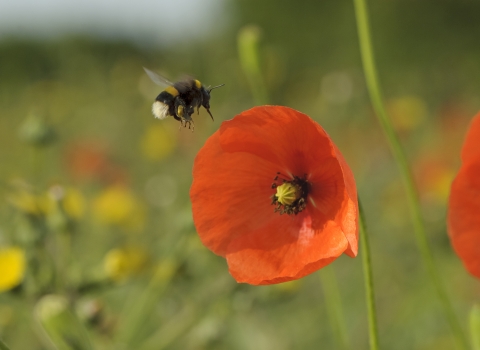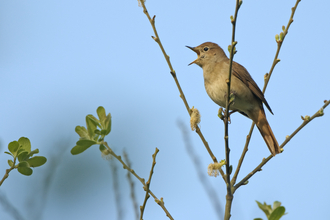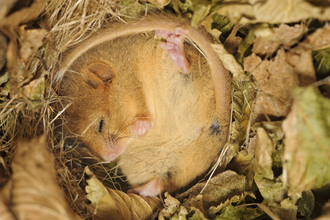Our position
Essex Wildlife Trust remains fundamentally opposed to the proposals for the redevelopment of Middlewick Ranges for housing.
Reason for this updated statement
This expanded and updated statement about Middlewick Ranges Local Wildlife Site (Co122) is in response to the Colchester City Council’s current Local Plan Review and the proposed selling of the land by the Ministry of Defence (MoD). This update also includes additional information on the sites’ wildlife importance.
This statement is made on behalf of both the Essex Wildlife Trust and its subsidiary, commercial ecological consultancy arm, Essex Ecology (formerly known as EECOS). Essex Ecology has surveyed all the City Council’s Local Wildlife Sites, several times, over the last 30 years and has provided ecological advice to Colchester City Council on their protection.
In spite of its special status for wildlife, recognised by its designation as a Local Wildlife Site in the Local Plan, and its importance to local people as a highly valued green space, Middlewick Ranges, perversely, remains threatened with destruction under the same Local Plan. This threat is in the form of a proposed housing allocation of 1,000 houses, which would destroy the site.
The importance of the site
Middlewick Ranges is an outstandingly significant site for biodiversity, not only for Colchester, but for Essex and the wider SE region. At 76 hectares it is one of Colchester City’s largest Local Wildlife Sites and, on its own, represents nearly 4% of the Council’s complete Local Wildlife Site acreage.
Furthermore, with tens of hectares of rare acid grassland, Middlewick Ranges encompass the largest extent of this special habitat in Essex, and the habitat is of the same ecological importance as acid grasslands of fully protected Sites of Special Scientific Interest, like Epping Forest SSSI.
The size and expanse of acid grassland is important and exceptional not only in Essex but the UK; Middlewick Ranges supports over 50 hectares of this Priority Habitat. The following statement of acid grassland size is from Natural England:
"Fragmentation is a major issue such that most sites are small. Data from 2011 showed that 71% of lowland dry acid grassland sites were less than 5 ha with only 6% being over 10 ha (Bullock et al., 2011). Currently, the minimum size for SSSI selection is 0.5 ha (Jefferson et al., 2014)."
Acid grassland is a type of natural dry grassland that grows on low fertility, sandy and gravelly soils, similar to lowland heath. In these exacting conditions, uncommon grasses and wildflowers thrive and a very unusual and special insect fauna develops. On Middlewick Ranges, the grassland and its underlying carbon-rich soils have been undisturbed for at least two centuries and were also part of an even more extensive grass-heath environment to the south of Colchester. This has allowed high levels of biodiversity to flourish.
Alterations to ecological evidence
The MOD/DIO commissioned Stantec to provide the ecology report which formed a crucial part of the evidence base used to justify the allocation of Middlewick Ranges in the Local Plan. This now widely discredited report included significant alterations to the existing and original ecological evidence.
Example 1 - Strategic significance of Middlewick
Under the Environment Act 2021 and in Defra's Statutory Biodiversity Metric User Guide (July 2024), Local Wildlife Sites are 'Areas of Particular Importance for Biodiversity' and, as such, are of High Strategic Significance. Even before the Environment Act, Local Wildlife Sites were fundamental to a District's biodiversity protection, as reflected in Local Plan policies, and would be considered as being of High Strategic Significance. In a tortuous rationale within the Stantec ecology report (para 1, p. 207), the high strategic significance of Middlewick Ranges is effectively disregarded and its existing status as a Local Wildlife Site is downgraded, with the issue of strategic significance being rendered "redundant" in the view of the report.
Example 2 - Subversion of the Mitigation Hierarchy
Both Colchester Council's original decision and the subsequent Stantec report completely subvert the principles enshrined in the Mitigation Hierarchy, which is a fundamental part of preparing development plans and assessing planning applications (National Planning Policy Framework, para 186a). Avoidance of development on a Local Wildlife Site is the first step in the mitigation hierarchy, and local authorities are expected to seek suitable alternative sites for housing allocations. Instead, the Council have now admitted that it had made the original housing allocation decision before any surveys had been conducted and despite the fact that the site was a Local Wildlife Site (Example 1, above). The Council has since felt it necessary to retrospectively justify the decision.
Furthermore, the Stantec report (Section 7) conflates avoidance (the first step in the mitigation hierarchy) with mitigation (the second step) and the line between these two fundamentally different steps is blurred. Compensation, the final step, is then almost immediately relied upon - a complete subversion of the process.
Example 3 - Habitat Map
Of all the alterations to ecological evidence contained in the Stantec report, the most egregious of all is the presentation of the habitat survey results.
The original ecology report for Middlewick Ranges conducted by Peter Brett Associates in 2017 correctly identified over 45 hectares of acid grassland on Middlewick Ranges. PBA also correctly identified over 65 hectares of semi-improved grassland south of Birch Brook Woodland off Weir Lane. The subsequent report published by Stantec used the content from the original PBA report, but some crucial alterations were made whereby certain habitats were reclassified without commentary or justification. Over 20 hectares of acid grassland in the north of the site, coincidentally where the housing development footprint is currently proposed, were downgraded to 'poor semi-improved' grassland. These areas of northern grassland within the proposed footprint (areas 'D', 'E' and 'F') were described by Stantec as "less ecologically valuable grassland"; despite supporting similar acid grassland flora and fauna as the fenced grassland (area 'A'), including Sheep's Sorrel and numerous specialist invertebrates with conservation status including Cerceris quadricincta and Cerceris quinquefasciata.
In addition, over 65 hectares of ecologically valuable semi-improved grassland at Weir Lane were downgraded to 'arable land', even described by Stantec as "ecologically benign (comparatively) arable land" despite being permanent grassland and supporting a range of species including short-eared owl, barn owl and skylark.
These alterations are highly problematic. They resulted in artificially enhancing the Biodiversity Net Gain score and significantly deviated from the original assessments, leading to a serious misrepresentation of Middlewick Ranges' ecological value. They contradicted the formal Local Wildlife Site citation - and this alone should have raised serious questions at the time.
New information since the Local Plan Examination of 2021
In relation to this biodiversity, the Government’s statutory adviser on nature conservation, Natural England, wrote to the Council in June 2022 and expressed its opinion that the significance of this special habitat was likely to have been underestimated during the examination of the Local Plan in 2021. However, of real and additional concern to Essex Wildlife Trust is that the site’s insect biodiversity was not properly addressed during the Local Plan preparation. Essex Ecology advised the Council’s officers in early 2021 that the site, with more survey work, was likely to reach a level to be considered of SSSI-level quality.
Since then, Colchester Natural History Society, together with Essex Field Club and Butterfly Conservation, have conducted further field surveys and their additional species lists were submitted to the Council in June 2022. This detailed survey work added to the already impressive list of rare species and discovered at least 23 Red Data Book Species, the rarest of the rare. The surveys also found a quarter of all Essex's known moth and butterfly species within the site’s 76 hectares.
We also now know the site plays a key role in supporting the UK's second largest population of nightingales (red listed, of the highest conservation concern), and the site also appears to be part of a network of sites supporting barbastelle bat (considered vulnerable to extinction in the UK using international criteria). There is significant evidence from 2024 surveys that barbastelle are breeding in Birch Brook Woodland using established methodology (Sussex University, 2023); regular use of Middlewick Ranges for commuting and foraging by barbastelles also suggests the site lies within a Core Sustenance Zone as per Bat Conservation Trust's definition.
Despite this wealth of new information, these species data do not seem to be addressed in the Council's current decision-making. There is already enough verified data to remove the site from the housing allocation, but this action remains to be taken.
Essex Wildlife Trust believes that Middlewick Ranges is almost certainly now of national importance for insect biodiversity and nightingales, forming part of the population which extends along the Roman River corridor (BTO 2021 in addition to updated 2024 survey work). For context, during the 2012 BTO survey this area including Middlewick Ranges supported around 2% of the national nightingale population; recent data suggests this may now be much higher.
Protection and mitigation
The mitigation proposed to deal with the planned destruction of this site, which was set out at the Local Plan examination in 2021, was completely flawed and would in no way safeguard the Ranges’ biodiversity. The proposed mitigation did not take into account the richness of the insect fauna nor the undisturbed, carbon-rich soils and, furthermore, proposed the ploughing up and destruction of old grasslands to the south of the Ranges.
For our part, the Trust would go further and add that safeguarding the green space for current and future generations of local people, and visitors from farther afield, is also of paramount importance for future well-being. Such a wildlife-rich, accessible, and large open space allows encounters and engagement with the full diversity of nature, where wildlife and human history combine to make it unique and irreplaceable.
Action required
It is clear that Colchester City Council's starting point and immediate focus for its current Local Plan Review is the enhancement of Colchester's green network. Essex Wildlife Trust warmly welcomes this strong commitment to "creating a better environment". Furthermore, Natural England, in its June 2022 letter (referred to above), stated it would expect the Council to safeguard this exceptional biodiversity, for which the Council is responsible.
With this clear direction, the Trust calls on Colchester City Council, with its strengthened duties to enhance biodiversity under the Environment Act 2021, to permanently safeguard Middlewick Ranges Local Wildlife Site.
In the face of the climate emergency and the UK's deepening biodiversity crisis, Essex Wildlife Trust believes that the full, long-term protection of Middlewick Ranges, and their management for wildlife and people, is essential. It is within the power of the City Council to ensure this is the future for this much-loved place.



